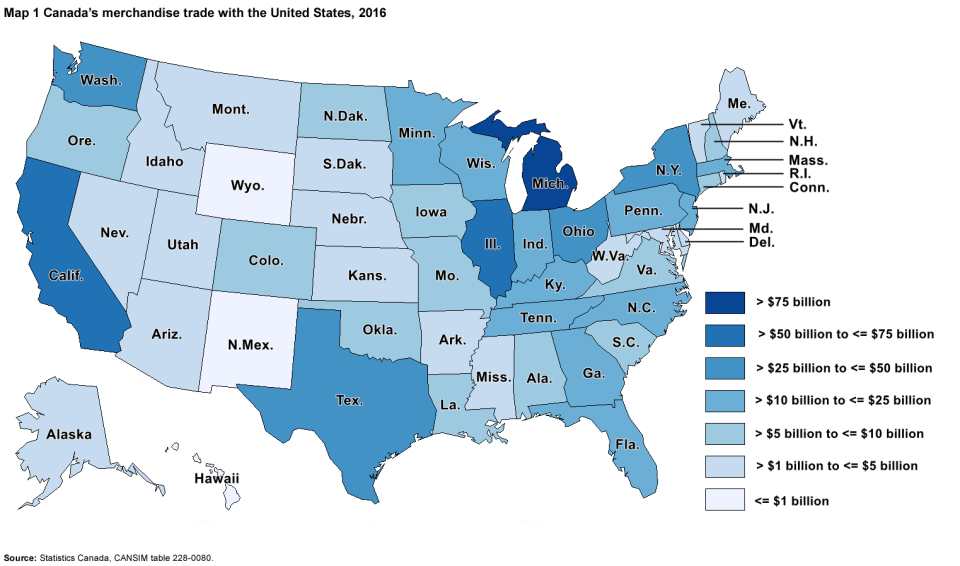Trudeau's meeting with Pence may reveal Canada's approach to NAFTA

Prime Minister Justin Trudeau’s bilateral meeting with U.S. Vice-President Mike Pence on Friday in Rhode Island will likely be a continuation of the charm offensive the Canadian leader has tried to maintain in the run up to the North American Free Trade Agreement (NAFTA) negotiations due to take place this August.
While Trudeau is holding a bilateral meeting with Pence, the most important part of today’s agenda is Trudeau’s meeting with over three dozen American governors, almost all of whom count Canada as their largest trade partner. The American governors are in Rhode Island for their annual summer meeting, a prime time for Trudeau to press the governors to express their continued support for NAFTA.
In turn, they will be also seeking to influence Trudeau, given that Canada is the biggest export destination for a majority of American states.
“[The governors are] looking to raise awareness about how fundamentally integrated our two economies are, how mutually beneficial the relationship is with Canada,” says Scotty Greenwood, once posted to the U.S. Embassy in Ottawa and currently a senior advisor to the Canadian-American Business Council. “They understand that in the U.S. that there are a lot of levers of influence and a lot voices that are involved in grand negotiations, and they recognize the crucial voice and role that governors play.”

Each of the states have different industries that are dependent upon Canadian investment. Snowbirds from the north provide an annual source of revenue for warmer states such as Arizona and Florida, while manufacturing states such as Michigan heavily depend on cross-border trade with Canada.
Included on the U.S. wish list are items such as e-commerce tariffs. Canada currently charges duties on online-purchased imports greater than $20, a tax called the de minimis charge. By comparison, imports to the U.S. get in duty-free if they are worth less than $800. There’s also the perennial issues of softwood lumber and supply-managed dairy.
“When it comes to lumber, we’ve had so many disputes with the Americans on this issue, and every single time it’s gone through the process, the Canadians have won,” says Walid Hejazi, an associate professor of international business at the University of Toronto’s Rotman School of Business.
However, the dairy industry may not receive the same level of support, Hejazi says. “The government will not say this in Canada, but supply management is a thorn in the side of the Canadian government.” However, it remains to be seen how well Canadians would respond to any announcement that the dairy industry was going to be opened up to imports, given the levels of support the system gets.
The Americans will also want to remove barriers that slow down cross-border trade with measures such as expanding customs pre-clearance facilities to ports and railway stations. While the pre-clearance agreement has been passed in the U.S. Congress, it has moved slower in Parliament. Concerns about the presence of armed U.S. guards in railway terminals and ports that the Canadian public also uses has held up legislation. Meeting with Trudeau may allow both the vice-president and governors from border states to press Trudeau for progress.
Given the high level of integration between the countries economies, there’s little fear of talks collapsing, as the effects would be detrimental to both parties. “Let’s say it this way: 10 million U.S. jobs depend on trade with Canada. If trade with Canada is tampered with, those jobs are at risk,” says Hejazi. “The thicker the border becomes, the larger the number of jobs the American economy will lose.”
However, even if the U.S. pulled out of NAFTA, two forces would temper the blow to Canada. The country could still rely on the terms of the Canada-U.S. Free Trade Agreement, signed in 1988. NAFTA, by comparison, simply deepened the level of integration that the Canadian and American economies were working towards while adding Mexico’s economy to free trade zone. The other force would be the trade rules Canada and the U.S. both adhere to by being part of the World Trade Organization, which sets a ceiling on tariffs and duties imposed on industrial goods among member nations.
“We welcome renegotiation, but we’d like to see an agenda that’s not just written by corporate Canada and isn’t about just trying to keep NAFTA the way it is,” says Sujata Dey, a trade campaigner at the Council of Canadians, a social action group that pushes for economic, environmental, and social justice in Canada.
“We’ve seen that there is a backlash against globalization and rightly so because all the kinds of agreements we have have been creating more power for corporations, giving them more ability to be able to have control over our destinies and there hasn’t been a lot in those agreements for people,” Dey says. “NAFTA is a prime example of that.”



